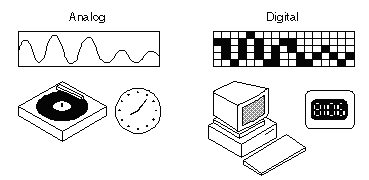DIGITAL
|
ANALOG
|
|
Describes
any system based on discontinuous data or events. Digital
representations consist of values measured at discrete intervals. |
The
principal feature of analog representations is that they are continuous. |
|
Computers are digital machines because
at their most basic level they can distinguish between just two values, 0 and
1, or off and on. There is no simple way to represent all the values in
between, such as 0.25. All data that a computer processes must be encoded
digitally, as a series of zeroes and ones. |
The
opposite of digital is analog. A
typical analog device is a clock
in which the hands move continuously around the face. Such a clock is capable
of indicating every possible time of day. In contrast, a digital clock is
capable of representing only a finite number of times (every tenth of a
second, for example). |
|
Digital
watches are called digital because they go from one value to the next without
displaying all intermediate values. Consequently, they can display only a
finite number of times of the day. |
Watches
with hands are analog, because the hands move continuously around the clock
face. As the minute hand goes around, it not only touches the numbers 1
through 12, but also the infinite number of points in between. |
|
A digital computer is designed to process data in
numerical form |
An analog computer represents data as physical
quantities and operates on the data by manipulating the quantities. It is
designed to process data in which the variable quantities vary continuously |
|
Its circuits perform directly the mathematical
operations of addition, subtraction, multiplication, and division. The
numbers operated on by a digital computer are expressed in the binary system |
Since most physical quantities, e.g., velocity and
temperature, vary continuously, as does audio, an analog circuit provides the
best means of representing them. |
|
Binary digits are easily expressed in the computer
circuitry by the presence (1) or absence (0) of a current or voltage. |
|
|
A digital computer can store the results of its
calculations for later use, can compare results with other data, and on the
basis of such comparisons can change the series of operations it performs.
Digital computers are used for reservations systems, scientific
investigation, data-processing and word-processing applications, desktop publishing,
electronic games,
etc. |
|
